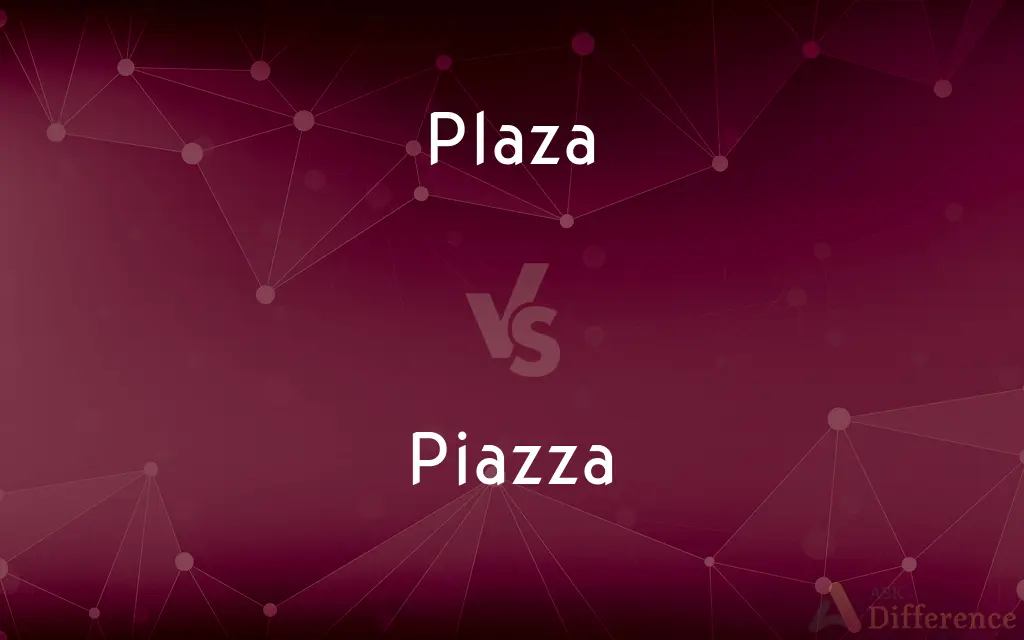Plaza vs. Piazza — What's the Difference?
By Tayyaba Rehman — Updated on September 28, 2023
A Plaza is a public square or open space in urban settings, often used for gatherings, while a Piazza is an Italian term for a town square or marketplace, similar in function but culturally distinct.

Difference Between Plaza and Piazza
Table of Contents
ADVERTISEMENT
Key Differences
A Plaza is often recognized as a city's open area where people can gather, socialize, or engage in activities. It can be found in various countries, and its design may differ based on cultural influences. On the other hand, a Piazza is a term rooted in Italian culture and represents the open spaces in Italian cities, often surrounded by historical or iconic buildings.
In many Latin American countries, a Plaza is a central element, serving as the heart of towns and cities. These Plazas are often places of historical significance, where events or ceremonies might take place. The Piazza, however, is deeply embedded in Italian architecture and urban design. If you walk around Italian cities like Rome or Florence, Piazzas are central to the city's life, with cafes, restaurants, and sometimes markets.
While a Plaza can be seen as a more generic term to describe open urban spaces, the Piazza carries with it a sense of Italian tradition and style. Many Piazzas in Italy are renowned for their architecture, sculptures, and fountains. A Plaza, in its essence, may not always have such detailed artistic features but is still vital for urban planning and public gatherings.
Both Plaza and Piazza serve similar functions in facilitating community gatherings and enhancing urban life. They are spaces that breathe life into cities, where people can pause from their busy lives. The primary difference lies in their cultural context: Plaza being a broader term and Piazza being distinctly Italian.
Comparison Chart
Cultural Origin
General; found in many countries.
Italian origin.
ADVERTISEMENT
Usage
Public square or open space.
Town square or marketplace in Italian cities.
Common Surroundings
May be surrounded by modern buildings or parks.
Often surrounded by historical or iconic buildings.
Events
Used for general gatherings or events.
May host local Italian festivals or market days.
Architectural Significance
Varies based on location.
Often renowned for unique Italian architecture and style.
Compare with Definitions
Plaza
A marketplace or shopping area.
The new Plaza downtown has a variety of stores and eateries.
Piazza
An Italian town square or marketplace.
The Piazza was bustling with tourists and vendors.
Plaza
A broad city square or avenue.
The grand Plaza was lined with statues and fountains.
Piazza
A gathering place in Italian urban design.
Locals met at the Piazza for their evening passeggiata.
Plaza
An open public space in urban settings.
The city center has a beautiful Plaza where people often gather.
Piazza
An area used for public gatherings in Italian cities.
Musicians often performed live in the Piazza during summer nights.
Plaza
A ceremonial or gathering place in many Latin American towns.
The town's Plaza was decorated for the annual festival.
Piazza
An open space surrounded by buildings or streets, especially in Italy.
The Piazza was adorned with a historic fountain in the center.
Plaza
An open area in a commercial building complex.
The office Plaza had benches for employees to relax during breaks.
Piazza
A public square, especially in an Italian town.
Plaza
A public square or similar open area in a town or city.
Piazza
A roofed and arcaded passageway; a colonnade.
Plaza
A widened roadway forming the approach to tollbooths on a highway.
Piazza
New England & Southern Atlantic US A veranda.
Plaza
A parking or service area next to a highway.
Piazza
A public square, especially in Italian cities.
Plaza
A shopping center.
Piazza
A veranda; a porch.
Plaza
A town's public square.
Piazza
(UK) A roofed gallery or arcade (for example around a public square or in front of a building).
Plaza
An open area used for gathering in a city, often having small trees and sitting benches.
Piazza
An open square in a European town, especially an Italian town; hence (Arch.), an arcaded and roofed gallery; a portico. In the United States the word is popularly applied to a veranda.
We walk by the obelisk, and meditate in piazzas.
Plaza
(North America) A strip mall.
Piazza
A public square with room for pedestrians;
They met at Elm Plaza
Grosvenor Place
Plaza
A shopping mall.
Piazza
A term reflecting Italian architecture and tradition.
The Renaissance-era Piazza was a testament to Italy's rich history.
Plaza
A public square in a city or town.
Plaza
A public square with room for pedestrians;
They met at Elm Plaza
Grosvenor Place
Plaza
Mercantile establishment consisting of a carefully landscaped complex of shops representing leading merchandisers; usually includes restaurants and a convenient parking area; a modern version of the traditional marketplace;
A good plaza should have a movie house
They spent their weekends at the local malls
Common Curiosities
What's the primary function of a Plaza?
A Plaza serves as an open space in urban areas for public gatherings or events.
Is a Piazza exclusive to Italy?
While rooted in Italian culture, the term "Piazza" can be used elsewhere, but its origins and strong association are Italian.
What might one find in a typical Piazza in Italy?
Piazzas often feature cafes, historical buildings, fountains, and sometimes market stalls.
Can a Plaza have commercial establishments?
Yes, a Plaza can have shops, restaurants, and other commercial entities.
Are Plazas only found in Latin America?
No, the term "Plaza" is used globally, but it's central to many Latin American towns.
Do Plazas always have monuments or statues?
Not always, but many Plazas feature public art or memorials.
Are Piazzas only in major Italian cities?
No, even smaller towns in Italy often have a central Piazza.
Are all Piazzas historically significant in Italy?
Many are, but not all. Some Piazzas might be newer or less historically significant.
What's the importance of a Piazza in Italian culture?
Piazzas are central to urban life, hosting gatherings, events, and reflecting Italy's rich architectural heritage.
How do Plazas affect urban planning?
Plazas provide open spaces in urban designs, enhancing aesthetics and public interaction.
Can a Piazza be located inside a building?
While typically open spaces, some modern buildings might have interior spaces called "Piazzas," especially in shopping contexts.
What makes a Plaza different from a park?
A Plaza is usually paved and more urban, while a park is typically green and might have recreational areas.
Can a city have multiple Plazas?
Yes, many cities have multiple Plazas, each with its unique character.
Can "Plaza" and "Piazza" be used interchangeably?
While both refer to open urban spaces, "Piazza" carries Italian cultural connotations, so they aren't exact synonyms.
How are Piazzas typically designed?
Piazzas often prioritize pedestrian movement, surrounded by buildings and featuring central landmarks or fountains.
Share Your Discovery

Previous Comparison
Crazy vs. Psycho
Next Comparison
Plaid vs. TartanAuthor Spotlight
Written by
Tayyaba RehmanTayyaba Rehman is a distinguished writer, currently serving as a primary contributor to askdifference.com. As a researcher in semantics and etymology, Tayyaba's passion for the complexity of languages and their distinctions has found a perfect home on the platform. Tayyaba delves into the intricacies of language, distinguishing between commonly confused words and phrases, thereby providing clarity for readers worldwide.















































